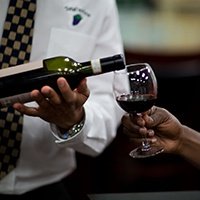South African winemaking began in the 17th century, with early Dutch and French settlers planting vines and making wine for export back to their homelands. But a renaissance of the industry began just 20 years ago, when historic political reform in South Africa ended the country’s social and economic isolation. Today, South Africa is attracting educated winemakers and investment from around the world and expanding its traditional winemaking regions into promising new terrain.
Almost all of South Africa’s winemaking takes place on the Western Cape, the region surrounding Cape Town at the bottom of the African continent. Summers are long and hot, but cool ocean winds from the south help create a Mediterranean climate. The region’s dramatic mountains – including the Drakenstein, Hottentots Holland and Langeberg ranges – offer a variety of microclimates and soils to suit a wide array of grapes.
The standard international varieties are at home in South Africa. Cabernet Sauvignon, Shiraz, Pinotage – a unique South African hybrid of Cinsault and Pinot Noir – and Merlot are among the country’s top red grape varieties, and Chenin Blanc (also known here as Steen), Sauvignon Blanc and Chardonnay among the top white grapes.
The Stellenbosch district, just east of Cape Town, is one of the country’s oldest and most acclaimed winemaking regions. The town of Stellenbosch hosts several universities and institutions devoted to viticulture and oenology. Red wines – particularly Cabernet, Merlot and Shiraz – thrive here, and white wine production is on the upswing. Other notable appellations in the Western Cape include Paarl, Constantia, Elgin, Walker Bay and Elim.
Befitting its history as a trade hub for sailing ships, the Western Cape is also known for its fortified, Port-style wines, originally devised to survive long sea journeys without spoiling.


